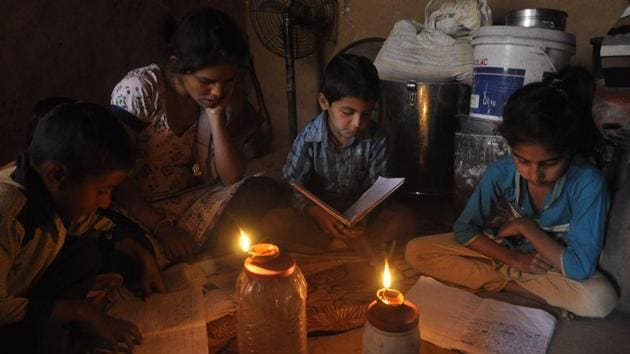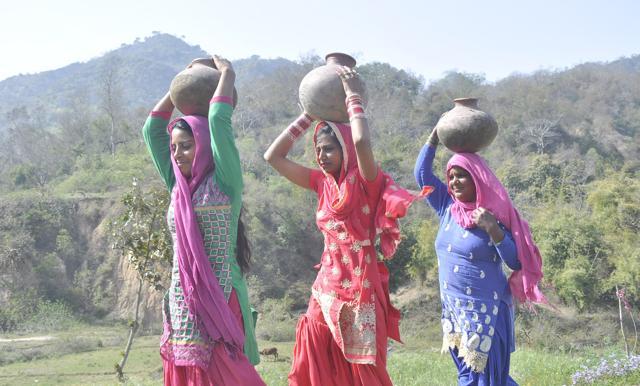HT Special | Life on the periphery: In Morni, life without light
Life here appears to be caught in a time warp. Though only 50 km from Panchkula and 60 km from Chandigarh, people in Morni have been without electricity for years now. Fans, television sets, geysers, refrigerators, the appliances we take for granted are a distant luxury for the people here. Bald poles without lamps are the only remains of a government plan to install solar lights, which proved to be a non-starter.
Life here appears to be caught in a time warp. Though only 50 km from Panchkula and 60 km from Chandigarh, people in Morni have been without electricity for years now. Fans, television sets, geysers, refrigerators, the appliances we take for granted are a distant luxury for the people here. Bald poles without lamps are the only remains of a government plan to install solar lights, which proved to be a non-starter.

They have water pipes, but there is barely a trickle in the summers and people have to walk a while to fetch water. At some places, animals and humans share water from the same source. Children walk five to 6km a day to reach schools, which are understaffed. Every time they look at the neighbouring Sirmaur district of Himachal Pradesh (HP), a stone’s throw away, where houses are illuminated and employment is easily available, they hope one day their life will also improve. In this backward area, the Dalits are hit the hardest. Singhwala is the last settlement of Morni block bordering Himachal Pradesh (HP).
There is no road when you reach here from Neemwala. You have to cross a river bed to reach this Dalit settlement, which doesn’t have land to till. The men either work as daily wage labourers under Mahatma Gandhi National Rural Employment Guarantee Act (MGNREGA) scheme or in factories in the neighbouring Sirmaur district. “There is no power, so we do not have fans, TV sets and heaters. Earlier, we used to get kerosene but now we have stopped getting that as well,” says Ratan Lal, 55, a daily-wager.
MORNI STATISTICS
Population: 21, 330 as per 2011 census
Police post: 1
Lakes: 2
“We are so poor that we can’t even shift to another place,” says Mahinder Singh, 41, who works as a labourer in HP.
Network connectivity is very poor. People have mobile phones that they charge with batteries powered by solar cells. Some have emergency light too, again run on batteries. Eight years ago, the state government had set up solar panels here, but they are turning dysfunctional now.
Pooja Rani, 30, a native of Ramgarh in Panchkula, who got married in Singhwala seven years ago, says she misses electricity that she took for granted at her parents’ house. “Only I know how I live here. I haven’t seen TV for ages. I watch it whenever I visit my parents,” says Pooja, whose husband is a factory worker in Kala Amb (HP) and travels 25-30 km every day.
Singhwala is a part of Dabsu panchayat. “Among 15 settlements in Dabsu, 12 are without power,” says Deepa Sharma, sarpanch, Dabsu.

The women here take care of the house. Young girls manage to study only up to Class 8,the highest grade offered by the nearest middle secondary school. But 17-year-old Reena Devi dares to dream. She wants to do diploma in a polytechnic. So she treks through the jungle almost 6km every day to reach her school in Baldwala village. She is now in Class 12th and has been busy with exams. “I want to do ITI (polytechnic diploma). But no one will send me so far to study,” says the girl whose father is a labourer.
Santosh Devi, 22, of Singhwala had to leave studies after middle standard as her parents did not want to take the risk of sending her so far.
“Girls have to go in a group to Baldwala school, for it is not safe to go alone,” says Reena, who tries her best to complete her school work in daylight.
The school in Singhwala has 22 primary and 15 middle-level students. “We have a sanctioned strength of two teachers for primary sections and three for middle school, but I am the only one posted here.
There is one guest teacher who comes for three days as he is posted elsewhere for the rest of the days. When he is not here, all the eight classes are taught together,” says Ram Lata, a teacher at Singhwala school. The school has no power or regular water supply.
Dabsu, whose sarpanch claims it is the most backward panchayat, has just three schools, two middle and one primary.
“The schoolchildren have to start as early as 6am to reach the road to take a bus. We have demanded an upgradation of our schools to higher level,” says Umesh Sharma, husband of the sarpanch.
In 2016, 371 students took the Class 10th Haryana board exams from the Morni block, but only 138 could clear it, which works out to a pass percentage of 37.1%. At Government Senior Secondary School (GSSS), Tikkar Hills, only eight out of 46 students managed to pass the exam. At 17.4 %, it had the lowest pass percentage in the block. The other poor performers in the block included GSSS Baladwala (24.4% pass percentage), GSSS Morni (31.3%); and GSSS Thandog (36.1%). Similarly, 19 out of 20 students in the commerce stream at GSSS Morni flunked the Class 12 Haryana board exams. Staff shortage is given as a reason for the poor results.

NO DEMARCATION OF MORNI FOREST LAND
The government acquired 50,807 acres of land in the Morni Hills between 1969 and 1979, and declared the area a protected forest under the provisions of the Indian Forest Act, 1927.
Later, forest settlement operations (survey and complete measurement of land) were started in 1987 under the supervision of the Forest Settlement Officer-cum-Sub Divisional Officer Kalka (now Additional Deputy Commissioner, Panchkula) to declare the protected forest a reserve forest, and to detect encroachments and stop theft of timber.
However, as per a CAG report, only 522 acres could be measured until October 1995. Thereafter, there was no progress. As per the revenue records, a total of 1,376 acres of land is under encroachment, added the CAG report.
The residents are demanding that the land cultivated by them should be restored to them as ‘Nau Taur’ as was done in Himachal Pradesh. A petition filed by Vijay Bansal of Shivalik Vikas Manch in this regard is pending before the high court.
POWER PANGS
Recently, Shivalik Development Board (SDB), which falls under the CM, has sanctioned money for the electrification of the Morni villages. There are 110 settlements which are without power, says MLA Kalka Latika Sharma. The SDB has been dragging its feet on the electrification of Morni due to the sparse population spread over a large area, which makes electrification a costly affair. Even now the work is going on at a slow pace. “I don’t think the electrification will be completed by May as promised,” says Deepa Sharma, the sarpanch.
MAGICAL MORNI
According to the district handbook of census, in ancient times, Morni hills were known as Mayur Giri. The Morni hills are the offshoots of the Shivaliks, which run in two parallel ranges. The village of Morni (Bhoj Jabial) lies on the mountain side, at 1,220 metres above mean sea level. Lore has it that the place gets the name Morni from a queen who ruled here.
.Among the spurs of hills lie two lakes, the larger known as Tikkar Taal, about 550 metres long and 460 metres broad, and the shorter about 365 metres either way. The former is a famous tourist spot. A hill divides the two lakes, but there is a hidden channel as the level of the two lakes remains the same. The people look upon the lakes as sacred. There is an old fort which is now being revived. The government is also trying to set up a herbal forest with the help of Patanjali Yog Peeth and work is going on.
HISTORIC TEMPLE
Samlasan Devi Temple is located on the highest peak at Nalaghat, about 6km from Morni village. The temple has 18 angles, and was built with heavy stones joined with iron nails.
RESIDENTS SPEAK
No roads are there for connecting villages. When it rains, we can’t take pregnant women to health centres. In summers, the water dries up. We have already started facing water shortage. Manphool Sharma, sarpanch, Bhoj Kudana
Dabsu is at the tail-end of the block, so it is deprived of all the facilities. There are no paved roads in most of the settlements. There is a severe water shortage in summers. Deepa Sharma, sarpanch, Dabsu
Many girls in the village leave education as their parents don’t allow them to travel through jungle to study in distant schools. I hope the authorities take note of our plight soon. Santosh Devi, a resident of Singhwala
My daughter has studied up to Class 5, while my sons have done matriculation. There is no nearby school for children to study further. Students have to trek to reach school. Ratan Lal, a resident of Singhwala
OFFICIAL TAKE
We had got sanctioned around Rs 2.25 crore from the Shivalik Development Board for electrification of 110 settlements of Morni. We will soon have bridges to connect Morni with Nahan. Latika Sharma, Kalka MLA





